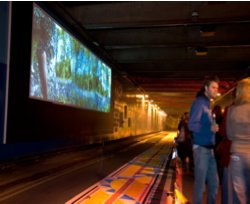|
Messaging in Public Display Systems (L)Status: Abgeschlossen
Public display systems are increasingly becoming a part of the urban landscape with systems being deployed in venues such as railway stations, shopping malls and city squares. However, most public display systems are simple one-way communications channels enabling controllers of the system to broadcast content to the general public - perhaps with limited interaction via SMS. The aim of this project is to develop a messaging system that opens up a large scale public display network to members of the public themselves - enabling them to post content to the screens and thus appropriate the displays for their own purposes. A key feature of the public display system in question is that each display supports scanning for Bluetooth devices so that users nearby can be identified through the presence of their cellular phone. This project will enable users to, for example, create messages that are displayed on public displays when a specified person is near to the display. The project consists of two main parts - a design and engineering task and a user study following deployment in the field. The specific goals are: To create a messaging system for a large-scale public display network that:
And, given such a system:
Trials and Travel OpportunitiesThe system will be built and tested at ETH and then trialed at Lancaster University. Lancaster has recently invested approx 1.2 million CHF in a research infrastructure to support experiments in public display systems. The resulting deployment, called e-Campus, will, when finished, feature nearly 100 displays ranging in size from small "smart doorplates" to large scale multi-projector installations. An API is available for creating applications that run on the e-Campus infrastructure and a small number of nodes will be deployed at ETH to facilitate development and testing. The user community at Lancaster consists of approximately 11,000 students and we hope that a significant percentage of these will participate in the user trial. The photos below (for photo credits please contact e-campus@comp.lancs.ac.uk) show a sample of current e-Campus installations. There will be an opportunity for students working on this project to base themselves at Lancaster during the trials if they wish and to work closely with other members of the e-Campus project team operating within the Computing Department in InfoLab21 (http://www.infolab21.lancs.ac.uk/).
Contact/Ansprechpartner: Marc Langheinrich, Nigel Davies |
|
|


